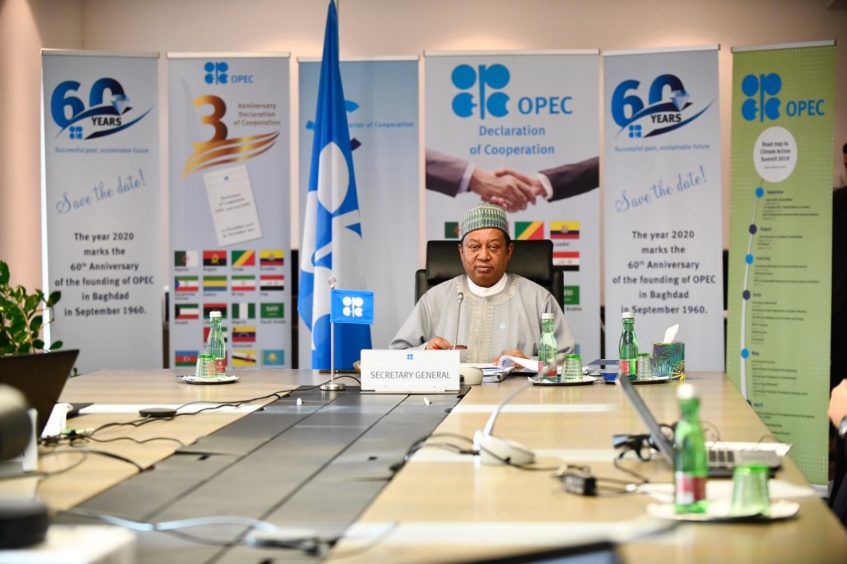
A historic multilateral deal to lower global oil production and stabilise prices, led by record cuts from Saudi Arabia and Russia, is at risk as Mexico refuses to agree to the proposed curbs.
The impasse threw into doubt efforts to revive the market from a debilitating coronavirus-induced slump. The deal by the group of nations known as OPEC+, which dwarfs previous interventions and has been encouraged by U.S. President Donald Trump, is also aimed at ending the price war between Riyadh and Moscow that helped pushed oil down to the lowest in almost two decades.
The deal is conditional on the consent of Mexico, which was the only participant not to agree to the proposal, OPEC said in a statement released after more than nine hours of talks via video link Thursday. The group doesn’t intend to meet again Friday, and will instead focus talks on a Group of 20 gathering scheduled that day, according to a delegate.
The tentative deal would result in cuts of about 10 million barrels a day during May and June. Saudi Arabia and Russia, the biggest producers in the group, would each take output down to about 8.5 million a day, with all members agreeing to cut supply by 23%, one delegate said.
The refusal by Mexico’s Energy Secretary Rocio Nahle Garcia to accept the proposed cuts reflects her country’s determination to keep as close as possible to the production and spending plans it’s been pursuing despite the crash. In a Twitter post shortly after leaving the meeting, she said the nation is ready to reduce output by 100,000 barrels a day, far less than the 400,000 barrels a day proposed by the group, and from a higher baseline.
Attention now turns to the G-20 energy ministers meeting Friday, where countries outside OPEC+, including the U.S. and Canada, could contribute as much as 5 million barrels a day of additional reductions.
Political Pressure
The unexpected setback doesn’t change the urgent need for the Organization of Petroleum Exporting Countries and its allies to reduce production. Crude’s spectacular crash this year has threatened the stability of oil-dependent nations, forced major companies such as Exxon Mobil Corp. to rein in spending and risked the existence of small independents.
“Mexico can and should join the international community in stabilizing the oil market,” said Aldo Flores Quiroga, the former Mexican deputy oil minister who negotiated OPEC+ deals from 2016 to 2018. “The production cut is both necessary and possible. It’s the responsible thing to do domestically and internationally.”
OPEC+ has been put under intense pressure by Trump — who spoke with the leaders of Russia and Saudi Arabia by phone on Thursday — and American lawmakers, who fear thousands of job losses in the U.S. shale patch.
“Both Saudi and Russia were going to have to cut anyway, and these cuts allow them to win political points too,” said Amrita Sen, chief oil analyst at consultant Energy Aspects Ltd.
While the headline cut equates to a reduction of about 10% of global supply, it makes up just a fraction of the demand loss, which some traders estimate at as much as 35 million barrels a day.
Oil prices have tumbled by half this year as the spread of the coronavirus coincided with a bitter price war that saw producers flood the market. Brent dropped 4.1% to $31.48 a barrel on Thursday, even as the agreement began to take shape. There’s no trading Friday in New York or London due to the Good Friday holiday.
“Covid-19 is an unseen beast that seems to be impacting everything in its path,” Mohammad Barkindo, OPEC’s secretary-general, said in a speech at the online gathering. “The supply and demand fundamentals are horrifying” and the expected oversupply, particularly in the second quarter, is “beyond anything we have seen before,” he said.
Barkindo urged action, from both OPEC+ producers and nations beyond the alliance, to tackle the growing surplus, which he estimated at 14.7 million barrels a day in the second quarter.
Russia has insisted that the U.S. in particular do more than just let market forces reduce its record production. Trump, meanwhile, has said America’s cut will happen “automatically” as low prices put shale in dire straits, a sentiment reiterated by his energy secretary Thursday. Separately, a senior administration official said the nation welcomed the proposed OPEC+ cuts, adding they would send a signal that all major oil-producing countries will respond in an orderly manner to market realities caused by the virus.
Tapering Off
OPEC+’s tentative plan would see the output curbs tapering off after two months, depending on the evolution of the coronavirus. The 10 million-barrel-a-day cut may shrink to 8 million a day from July and then 6 million a day from January 2021 to April 2022, according to the OPEC statement. The group is planning another videoconference June 10 to discuss what additional measures need to be taken.
Saudi Arabia and Russia will apply reductions to a production baseline of about 11 million barrels a day, according to the OPEC statement. For Saudi Arabia, that’s lower than recent output, which rose above 12 million a day in early April. Other countries would cut from their October 2018 levels.
The oil price war, which started in March after the collapse of previous OPEC+ talks, lasted exactly 31 days, far fewer than similar feuds in 1986, 1998 and 2016. But in that short period, it has forced companies from Big Oil giants to U.S. shale independents to slash spending, fire workers and cancel projects. Meanwhile, oil-rich countries have gone cap-in-hand to the International Monetary Fund and the World Bank for help, hobbled by low prices.
“For oil markets, the massive oil-demand contraction is unprecedented,” OPEC said in an internal document circulated to ministers and seen by Bloomberg. “The current outlook looks extremely bleak, with oil markets anticipated to be severely tested on many fronts.”